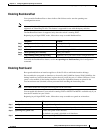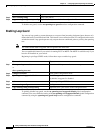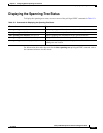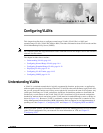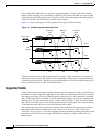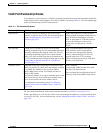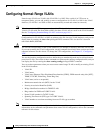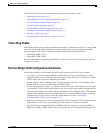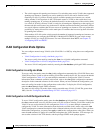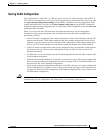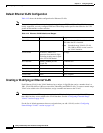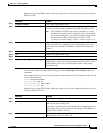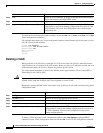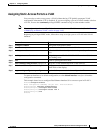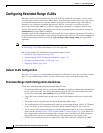
14-5
Catalyst 2950 Desktop Switch Software Configuration Guide
78-14982-01
Chapter 14 Configuring VLANs
Configuring Normal-Range VLANs
This section includes information about these topics about normal-range VLANs:
• Token Ring VLANs, page 14-5
• Normal-Range VLAN Configuration Guidelines, page 14-5
• VLAN Configuration Mode Options, page 14-6
• Saving VLAN Configuration, page 14-7
• Default Ethernet VLAN Configuration, page 14-8
• Creating or Modifying an Ethernet VLAN, page 14-8
• Deleting a VLAN, page 14-10
• Assigning Static-Access Ports to a VLAN, page 14-11
Token Ring VLANs
Although the switch does not support Token Ring connections, a remote device such as a Catalyst 5000
series switch with Token Ring connections could be managed from one of the supported switches.
Switches running VTP version 2 advertise information about these Token Ring VLANs:
• Token Ring TrBRF VLANs
• Token Ring TrCRF VLANs
For more information on configuring Token Ring VLANs, refer to the Catalyst 5000 Series Software
Configuration Guide.
Normal-Range VLAN Configuration Guidelines
Follow these guidelines when creating and modifying normal-range VLANs in your network:
• See Table 14-1 for the maximum number of supported VLANs per switch model. On a switch
supporting 250 VLANs, if VTP reports that there are 254 active VLANs, four of the active VLANs
(1002 to 1005) are reserved for Token Ring and FDDI.
• Normal-range VLANs are identified with a number between 1 and 1001. VLAN numbers 1002
through 1005 are reserved for Token Ring and FDDI VLANs.
• VLAN configuration for VLANs 1 to 1005 are always saved in the VLAN database. If VTP mode
is transparent, VTP and VLAN configuration is also saved in the switch running configuration file.
• The switch also supports VLAN IDs 1006 through 4094 in VTP transparent mode (VTP disabled)
when the EI is installed. These are extended-range VLANs and configuration options are limited.
Extended-range VLANs are not saved in the VLAN database. See the “Configuring
Extended-Range VLANs” section on page 14-12.
• Before you can create a VLAN, the switch must be in VTP server mode or VTP transparent mode.
If the switch is a VTP server, you must define a VTP domain or VTP will not function.
• The switch does not support Token Ring or FDDI media. The switch does not forward FDDI,
FDDI-Net, TrCRF, or TrBRF traffic, but it does propagate the VLAN configuration through VTP.



